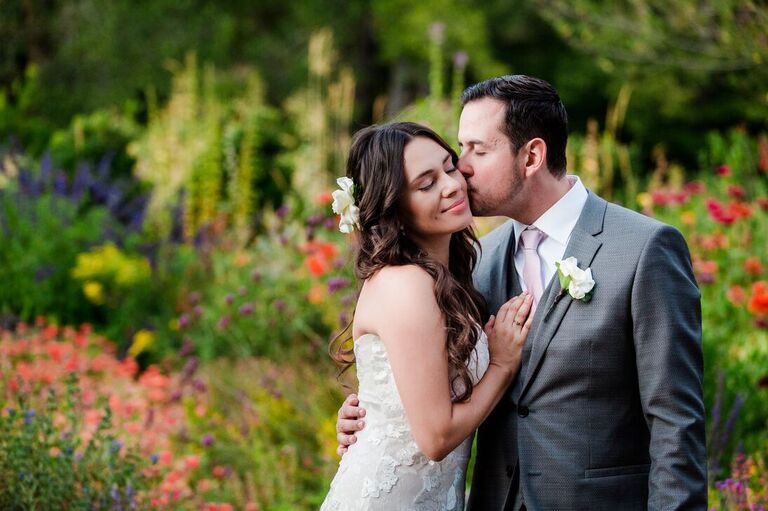The Ultimate Guide to Spanish Wedding Traditions and Customs
If you or your significant other are planning (or attending) a Spanish wedding or you're having a destination wedding in Spain, you might want to consider incorporating or understanding the culture's wedding traditions. From delicious food and unique attire to longstanding ceremony customs and bright florals, there are plenty of ways to give a nod to this vibrant culture throughout your big day.
To gain a better understanding of the Spanish traditions you may want to incorporate in your big day, or if you're just planning on attending a Spanish wedding in the near future, we tapped Lorie Lau of H+L Lovely Creations. She gave us the lowdown about everything you need to understand about Spanish wedding traditions.
A Brief History of Spanish Wedding Traditions
Spanish weddings have many traditions that are passed down from generation to generation. Many of the customs are rooted in Catholic wedding traditions, since it's the most practiced religion in the country. "The family is the main support system for the couple, in most traditional Hispanic weddings, the parents of the bride are the ones to pay for everything at the wedding and the groom and his parents are in charge of the alcohol, expenses of the civil ceremony, the wedding rings and the honeymoon," Lau described. "There is an increase in modern couples in the Hispanic culture, who will prefer to pay for the wedding themselves." They're typically larger-than-life affairs with lots of friends and family members in attendance and last late into the evening. Like any tradition, some couples choose to put their own spin on things. Below are a few common Spanish wedding traditions.
Spanish Prewedding Traditions
"Premarital counseling for the couple [is a given] before a Catholic wedding," Lau explained. It's also customary that the bride and groom do not see each other in the hours leading up to the wedding. Typically a close family member takes on the role of keeping the couple from sneaking a peek before the big day.
Spanish Wedding Attire
Bridal Attire
Like any other wedding, Spanish brides have traditional attire they tend to wear during the wedding ceremony. A longstanding wedding custom is for the bride to wear a black wedding dress, which signifies her commitment to her groom. Today's brides usually don't wear all black but may nod to it by incorporating it somehow. Many Spanish brides also wear a mantilla, or an intricate lace veil. Mantillas are typically passed down through generations of Spanish women.
Groom Attire
At some traditional Spanish weddings, the groom's close friends may take the groom's tie and cut it up into pieces. Then, they'll take the pieces and sell them to guests as a way to raise money for the couple.
Spanish Wedding Ceremony Traditions
No Wedding Party
One major way that Spanish wedding traditions differ from other cultures is that there are no bridesmaids or groomsmen in the wedding party. Instead, at a traditional Hispanic Catholic ceremony, the couple has padrinos. They will "take care of specific things for the wedding ceremony but most importantly will play the role of counselors/advisors for the newlyweds throughout their marriage," Lau explained. "These padrinos are picked by the bride and groom, they can be a family member, like aunts and uncles." At a traditional Christian ceremony, however, there is no need for padrinos, unless the couple wants them for spiritual counseling.



Orange Blossoms
Florals are a big part of any Spanish wedding ceremony. Orange trees are plentiful throughout Spain, making them a common choice for wedding flowers in Spain. They also represent joy and happiness for the newlyweds.
Las Arras Matrimoniales
This particular wedding tradition has been passed down for generations. It's performed at Catholic weddings in Spain and other Hispanic cultures worldwide. So what is it exactly? Las arras matrimoniales translates to wedding coins in English. They're often a gift from the padrinos and there are typically 13 of them to represent Jesus and his 12 apostles. 12 of them are gold and one of them is platinum. The coins are presented to the couple during the wedding ceremony. They represent good luck and financial prosperity for the married couple.
Wedding Bands
When a Spanish woman becomes engaged, she wears her engagement ring on her ring finger on her left hand. On the wedding day when the couple exchanges vows, she puts her wedding band on the ring finger on her right hand, versus stacking them both on the left hand.
Spanish Wedding Reception Traditions
The Head Table
Since there aren't usually bridesmaids and groomsmen, the head table is typically set for six people, including the bride, the groom and their respective parents. In some cases other close family members may join the bride and groom at the table.
Seguidillas Manchegas
This is a traditional wedding dance that happens during the reception. It's also known as the money dance because guests pay to dance with the bride. The money raised goes toward funding the married couple's new life together.
Wedding Favors
The bride and groom will often walk around the reception and give their guests favors as a way of saying thank you for attending.
Spanish Wedding Food, Drinks and Dessert
Paella
Paella is a traditional Spanish dish with seafood, vegetables and rice that's commonly served at big gatherings like weddings. It's cooked over an open flame in a large, flat frying pan and meant to be shared, and represents unity and togetherness. Other common foods at Spanish weddings include tapas, gazpacho and spit-roasted meat.





















